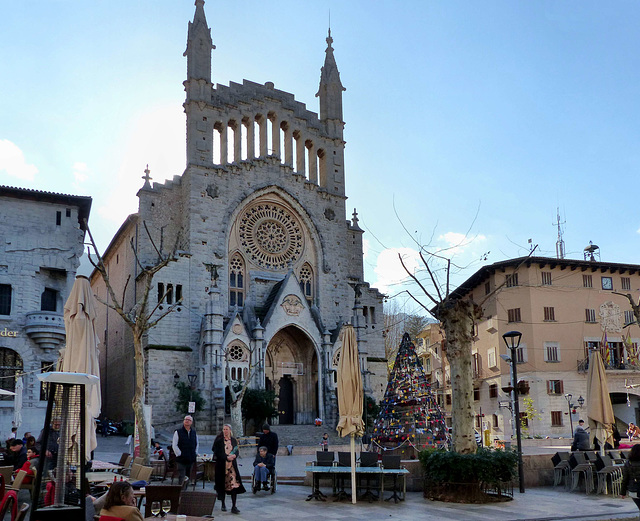Sóller - Banco de Sóller
Sóller - Tranvía de Sóller
Port de Sóller
Sóller - Plaça Constitució
The Wonders of Mallorca: Sóller – Its trains and…
Port de Sóller | Ferrocarril de Sóller
Port de Sóller | Ferrocarril de Sóller
vistes a la badia de Port de Sóller (© Buelipix)
Port de Sóller - Puerto de Soller (© Buelipix)
Port de Sóller - Puerto de Sóller (© Buelipix)
Port de Sóller- Puerto de Sóller (© Buelipix)
Port de Sóller - Puerto de Sóller (© Buelipix)
Reflexions al Port de Sóller (© Buelipix)
Port de Sóller - Puerto de Sóller (© Buelipix)
Port de Sóller- Puerto de Sóller (© Buelipix)
Port de Sóller- Puerto de Sóller (© Buelipix)
Coll de Sóller (© Buelipix)
Coll de Sóller (© Buelipix)
mal temps al Coll de Sóller (© Buelipix)
senyals clares a peu de carretera (© Buelipix)
Sóller - Jo recordo anteriorment (© Buelipix)
Sóller - Jo recordo anteriorment (© Buelipix)
Sóller - Soller (© Buelipix)
Sóller - Soller (© Buelipix)
The trams of Sóller
tram ticket
LLASER
Port de Sóller
coming into Port de Sóller
English Electric Co
family tram
cab
we're on the tram
Sóller Railway Station
Banco Sóller
Location
See also...
See more...Keywords
Authorizations, license
-
Visible by: Everyone -
All rights reserved
-
76 visits
Sóller - Sant Bartomeu


Mallorca is the largest island in the Mediterranean Balearic Islands, which are part of Spain. Mallorca is an extremely popular holiday destination. The Palma de Mallorca Airport, one of the busiest in Spain, is used by about 30 million tourists per year.
After the fall of the Western Roman Empire, the island was invaded by the Vandals in 425. The time of the Vandals ended, when Byzantine troops general took the island in 534. The first Muslim arrivals were in 707. These ended the Byzantine domination and established their own hegemony. Until 903, the island was part of the Umayyad Caliphate.
From Between 902 and 1229 the island was under Islamic control. James I of Aragon ( aka "Jaume el Conqueridor") conquered Mallorca in December 1229.
Sóller lies in a large, bowl-shaped valley, surrounded by the Tramuntana mountain range. It was known for olive oil in Moorish times, but since the late 18th century mainly oranges and lemons are grown here in are large orchards. The town got very prosperous through the trade and keeps its grows today - through tourism.
The first church here got erected just after the Reconquista but already in 1370 the church became dilapidated and so the construction of a new church began, which was consecrated in 1492. After the attack by Turkish pirates in 1561 a kind of fortress was built around the church, so it could serve as a refuge. After the church became dilapidated again, the construction of a new church in baroque style began at the end of the 17th century. The walls of the fortress were partly used as the outer walls. The consecration took place in 1711, though it was not completed at that time.
The new facade, which was added from 1904 to 1912 according to plans by Gaudí's student Joan Rubió. It is in late Modernism/neo-Gothic forms, with a large rose window in the centre, flanked by two slender pinnacle towers.
After the fall of the Western Roman Empire, the island was invaded by the Vandals in 425. The time of the Vandals ended, when Byzantine troops general took the island in 534. The first Muslim arrivals were in 707. These ended the Byzantine domination and established their own hegemony. Until 903, the island was part of the Umayyad Caliphate.
From Between 902 and 1229 the island was under Islamic control. James I of Aragon ( aka "Jaume el Conqueridor") conquered Mallorca in December 1229.
Sóller lies in a large, bowl-shaped valley, surrounded by the Tramuntana mountain range. It was known for olive oil in Moorish times, but since the late 18th century mainly oranges and lemons are grown here in are large orchards. The town got very prosperous through the trade and keeps its grows today - through tourism.
The first church here got erected just after the Reconquista but already in 1370 the church became dilapidated and so the construction of a new church began, which was consecrated in 1492. After the attack by Turkish pirates in 1561 a kind of fortress was built around the church, so it could serve as a refuge. After the church became dilapidated again, the construction of a new church in baroque style began at the end of the 17th century. The walls of the fortress were partly used as the outer walls. The consecration took place in 1711, though it was not completed at that time.
The new facade, which was added from 1904 to 1912 according to plans by Gaudí's student Joan Rubió. It is in late Modernism/neo-Gothic forms, with a large rose window in the centre, flanked by two slender pinnacle towers.
Dimas Sequeira has particularly liked this photo
- Keyboard shortcuts:
Jump to top
RSS feed- Latest comments - Subscribe to the comment feeds of this photo
- ipernity © 2007-2024
- Help & Contact
|
Club news
|
About ipernity
|
History |
ipernity Club & Prices |
Guide of good conduct
Donate | Group guidelines | Privacy policy | Terms of use | Statutes | In memoria -
Facebook
Twitter

Sign-in to write a comment.